In 2020, 88.05 % of online shopping carts were abandoned one step before shoppers made an order. Such figures point to the urgency of the shopping cart abandonment problem. Instead of looking for new promotion tools, it’s sometimes more beneficial to clarify the reasons why shoppers abandon their digital carts on your eCommerce website.
What can you get if you reduce the shopping cart abandonment rate? The answer is easy. The lower the rate, the more orders you get and the more you earn. Moreover, solving the digital shopping abandonment problem is easier and less costly than finding new clients.
In this article, we’ll talk about shopping cart abandonment solutions. We’ll also go through the reasons for abandoned carts and the consequences of this notion.
What Is Digital Shopping Cart Abandonment?
The shopping cart abandonment rate is one of the key performance indicators (KPIs) for an eCommerce business. To learn about other KPIs to be tracked by online retailers, check out our article. In this blog post, we review the most important metrics that directly and indirectly influence your profit.
Online shopping cart abandonment denotes the situation when a user puts a product (or products) into the shopping cart and then abandons it instead of placing an order. The shopping cart abandonment rate shows the number of such situations in percentage terms. Here is some data on shopping cart abandonment rates by industry and product:
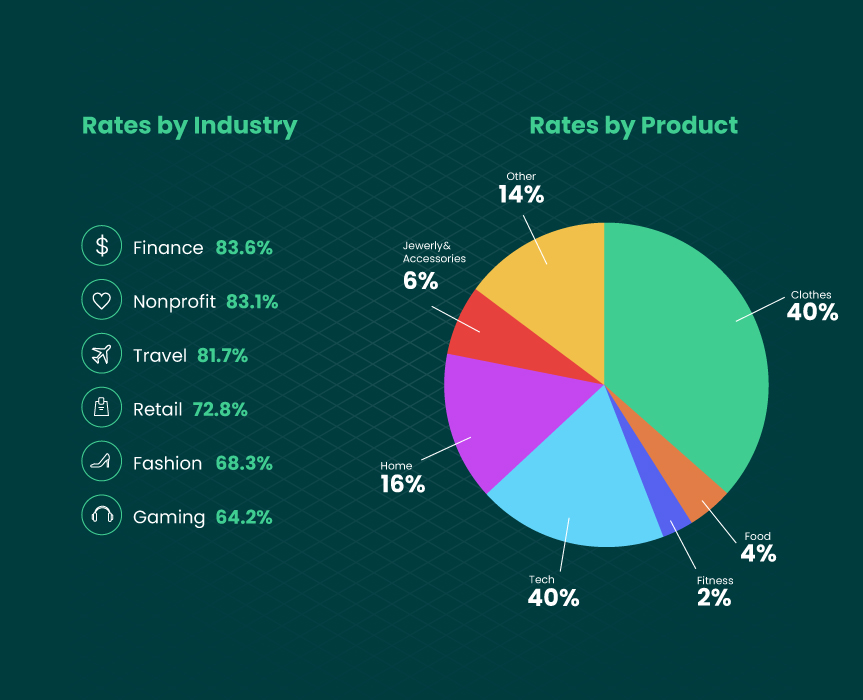
The number of created shopping carts determines customer interest in the products or services you offer. Users get engaged by your marketing efforts. They like your website design and business mission. They are almost ready to place an order. But something makes them change their mind and leave one step before they turn into clients.
A high abandonment rate may point to the problems shoppers face while going through the customer journey. These can be usability issues, system bugs, unclear layouts, etc. By fixing the reasons for their dissatisfaction, you grow sales and increase client retention.
How to Calculate Your Shopping Cart Abandonment Rate
You’ll need two metrics: the number of completed orders and the number of initiated shopping carts. To calculate the rate, use the formula:

For example, you got 100 orders last week. Meantime, there were 300 shopping carts created on your website. Firstly, we divide the number of orders (or transactions completed) by the number of shopping carts initiated and get 0.33. Then we subtract 0.33 from 1 and multiply the given number by 100. In this case, you will report shopping cart abandonment of 66%.
But what kind of result indicates that it’s time to worry? Let’s discuss this question in more detail.
What Shopping Cart Abandonment Rate Is Acceptable
Ecommerce business owners want to know what shopping cart abandonment rate is considered good and bad. Everything depends on the peculiarities and scope of your business, competition, your goals online, etc.
But here’s the rate of digital shopping cart abandonment that ecommerce stores face on average. According to Baymard Institute, the average cart abandonment rate is 69.82%. So, if your abandonment rate is around 65-70%, you reflect the common tendency.
It’s impossible to reach the 0% shopping cart abandonment rate. Not always, cart abandonment is determined by the quality of service. Some clients may leave their shopping carts simply because they use them for comparing prices, calculating the approximate cost of their wishlist, and for other reasons you cannot influence.
However, there are a lot of aspects that you can and should control. The number of cart abandonments will never be “too small.” There will always be room for improvement.
And finally, why is shopping cart abandonment a problem at all? These 2021 figures speak for themselves:

5 Reasons for Shopping Cart Abandonment
It’s time to review the common reasons for cart abandonment and cart abandonment solutions that can help you increase the number of placed orders.
Problem #1: Insecure or inconvenient payment options
A trusted business owner would never integrate insecure payment methods into their eCommerce website. Offering multiple payment options is not enough. The payment security should also be proved and well demonstrated. You have to show your customers that their payment details are protected and there is no chance of data breach.
Worrying about the security of payment is one of the top 5 reasons for order abandonments during checkout. If your shoppers doubt the security of the checkout flow, you get lost sales. And if you don’t assure customers security, they’ll probably look for it on another website. Most likely, the well-known one.
To outstand the competition and fight the pressure of business giants, you have to differentiate by the ecommerce security and convenience that your buyers get. Today, one of the most popular payment methods is using digital wallets or mobile payment, such as Apple Pay.
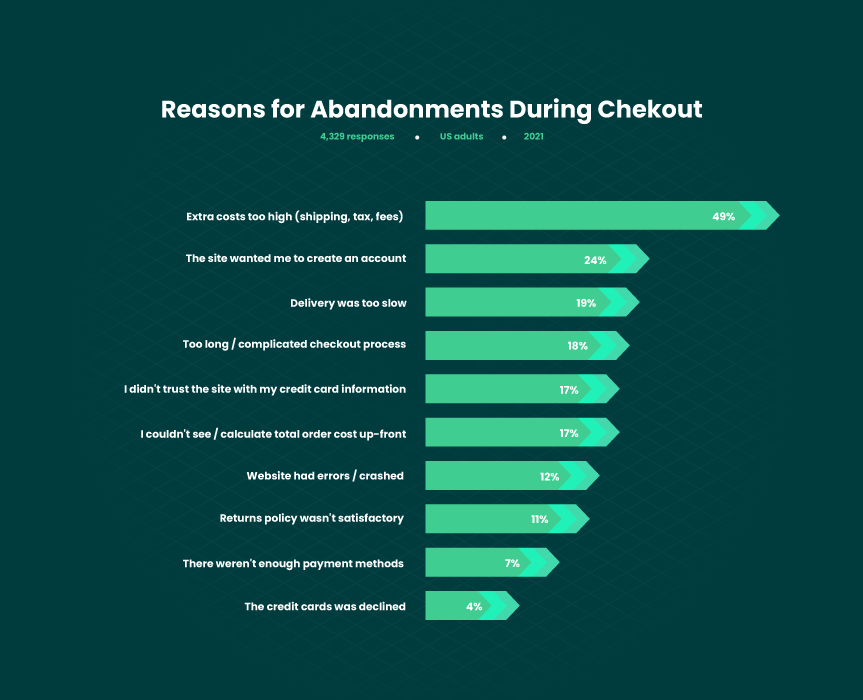
Solution:
Here comes the first tip for shopping cart recovery. It’s pretty natural that your buyers do not want to put their payment information at risk. To dispel the security doubts, integrate safe payment methods into your website. These, for example, include PayPal, SiteLock, Norton, and others. Also, you have to add a trust seal to the page where shoppers expect to make a payment. Check the example below.
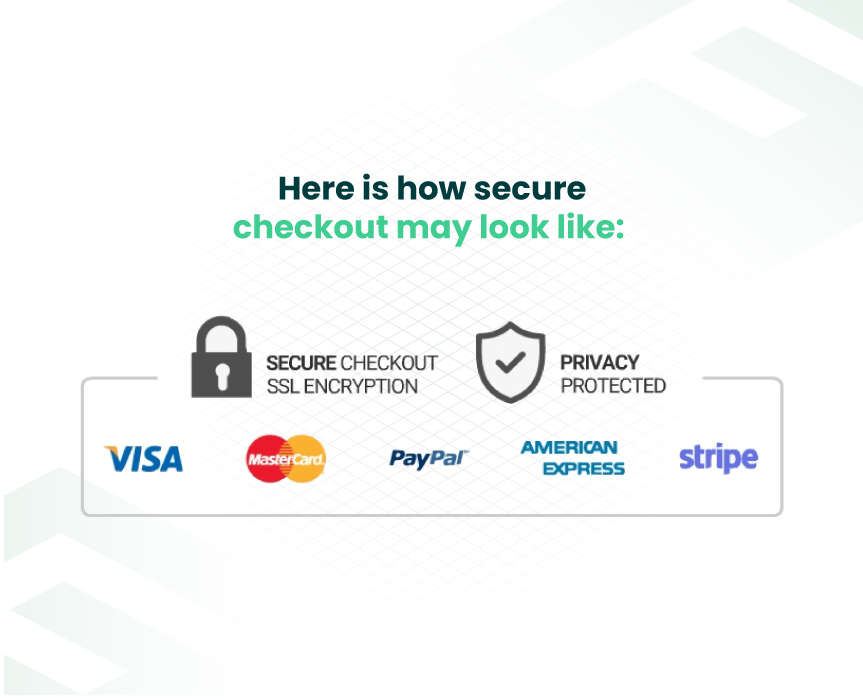
The impact of trust seals is described in the study by Conversion Fanatics, the company that develops strategies for conversion improvement. After they added trust seals to the checkout page, their conversion rates increased by 28.2%. Here is another impressive result: the company’s revenues raised by nearly 71% per user!
To protect clients’ data, find a reliable software development company that will integrate secure payment methods into your online store, increasing user trust and client retention.
Problem #2: Extra charges
Online buyers don’t have a consultant in place to purchase immediately. They don’t have a helpful hand to weigh the pros and cons of a particular product. Most frequently, users base their choice on client reviews and pricing. Shoppers see the product they like, and if the price is satisfactory, they put it into their shopping cart. And only at the checkout stage does it turn out that they have to pay the additional charge. It may include taxes, unexpected cost of packaging, high shipping costs, etc.
55% of the survey’s respondents named hidden costs a reason for abandoning their online shopping carts. To reduce the online shopping cart abandonment rate, make sure that client-company cooperation is transparent from beginning to end. Probably, some percentage of clients will accept extra fees and proceed with the order. Yet, at least 55% of users will leave their carts abandoned and start looking for a better offer.
Solution:
Not always, a retailer can avoid extra charges associated with an online purchase. For instance, taxes are imposed on the legal level, and if not to include them in the payment sum, you will lose your own money. The best strategy is to inform a client about shipping fees right from the start. Even if you are going to add some additional charges at the checkout stage, notify your client about them at the prior stages.
For example, this is what the shopping cart of Walmart looks like. Since the sum of taxes depends on the user’s location, it is calculated at the final stage of placing an order. Still, Walmart keeps a client informed that it is not the final sum and that extra fees are added at checkout.

Being transparent reduces the number of annoyed and disappointed clients. You can mention the extra costs on the product pages and let your clients choose among several shipping options with different pricing. The wider choice you offer, the more likely users are to proceed with an order.
Problem #3: Poor usability
In many cases, the reason for a high online cart abandonment rate lies in the steps a client has to take prior to checkout. But sometimes, the checkout stage is the main reason itself. Confusing checkout processes caused by poor usability is one more precondition for leaving shopping carts abandoned.
A too complicated checkout process is the reason for lost revenue. It irritates online shoppers. Customers leave websites because of unexpected shipping costs, unclear CTAs, annoying pop-ups, or ads. All these aspects affect the quality of the user experience on your website.
Solution:
Keep the form boxes clear and simple. If the information is not essential for processing an order, make it optional to fill in. Also, try to automate repetitive aspects of the checkout process to save clients time. For instance, instead of asking a user to fill in the shipping and billing addresses separately, add the function of address duplication. It will allow clients to use the billing address as the shipping address by putting a tick near the necessary function. Also, offer a one-click checkout option for those who don’t want to spend time on it at all.
You can improve the user journey with intuitive and laconic UI and UX ecommerce design. Make sure that your website’s appearance inspires buyers to make an order. Avoid alarming color shades and find trusted UI/UX designers that will express your business identity in the digital space.
Problem #4: Technical issues and bugs
High shopping cart abandonment can be caused by the poor tech performance of your website. The situation becomes doubly hard to detect when the problem occurs not to all users but only to a particular segment.
For instance, people who access your ecommerce site via mobile may face difficulties. Those who open it via laptop may not. If you test your website only on desktop, you don’t know what’s happening on mobile. No matter the device, the natural client’s response to the crashed website is simply leaving it. Moreover, if the page loads for more than 3 seconds, cart abandoners quit it as well. This is why you should care about your eCommerce site speed. Make your site bug-free and minimize load times to earn new clients.
Solution:
To reduce cart abandonment, refer to site optimization. Don’t forget to optimize your eCommerce store to different devices. There is a very real possibility that the high shopping cart abandonment rate on mobile devices is due to ecommerce sites not being mobile-friendly. Offer a seamless shopping experience on mobile. You’ll improve the odds for conversion as well as your SEO ranking.
Another means for detecting tech-related problems is to gather client feedback and conduct client research. Reach out to your customers and ask them what they think of their shopping experience. This can help you understand the data you have gathered and improve your eCommerce store accordingly.
Problem #5: Compulsory registration
Online buyers prefer eCommerce websites over brick-and-mortar stores because shopping online is quick, easy, and convenient. Yet, at least once in life, each of us faced the following. We look for a book/movie for a long time and find it on a website. We click on the “download now” button and feel relief. We are almost at the destination. It’s downloaded at 97%. Here comes 98, 99%… Danm, are you serious? The website obliges you to register before finishing downloading.
Would you register after the frustration and annoyance you had to feel? There is not much of a chance. The same works for your clients. Online buyers want to get enough flexibility and freedom while using your website. They want to have the right to choose whether to register or not and avoid dozen of steps before placing an order.
Businesses often put compulsory registration at the end of the user journey. By doing so, they try to outwit their clients. Unfortunately, they only make things worse for themselves, letting the user feel frustrated and go to a competitor.
Solution:
To address cart abandonment, make the registration optional. If you ensure the guest checkout option, your clients will be able to place an order without signing up. ASOS, for example, offers the guest checkout options but asks buyers to enter their email which is collected for marketing purposes:
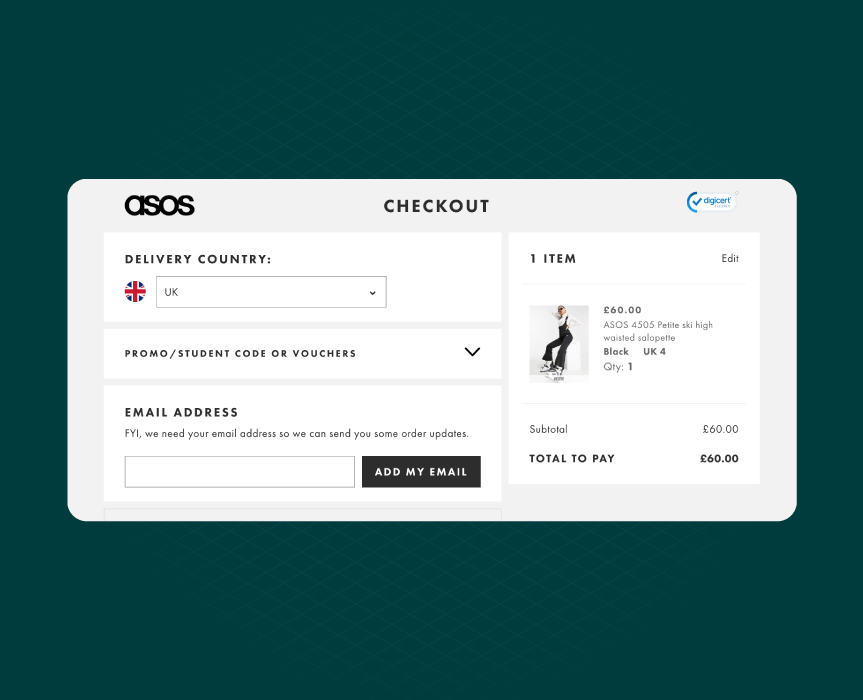
One of the additional abandoned cart strategies is to make the checkout process effortless. Inform a client about the obligatory registration before they move to the checkout stage. Or do even better: offer a guest checkout option as ASOS does. This will reduce checkout abandonment and improve your cart abandonment statistics. Also, you can make the user life easier if you integrate the means of quick registration into your eCommerce store. This is how eBay implements this solution:
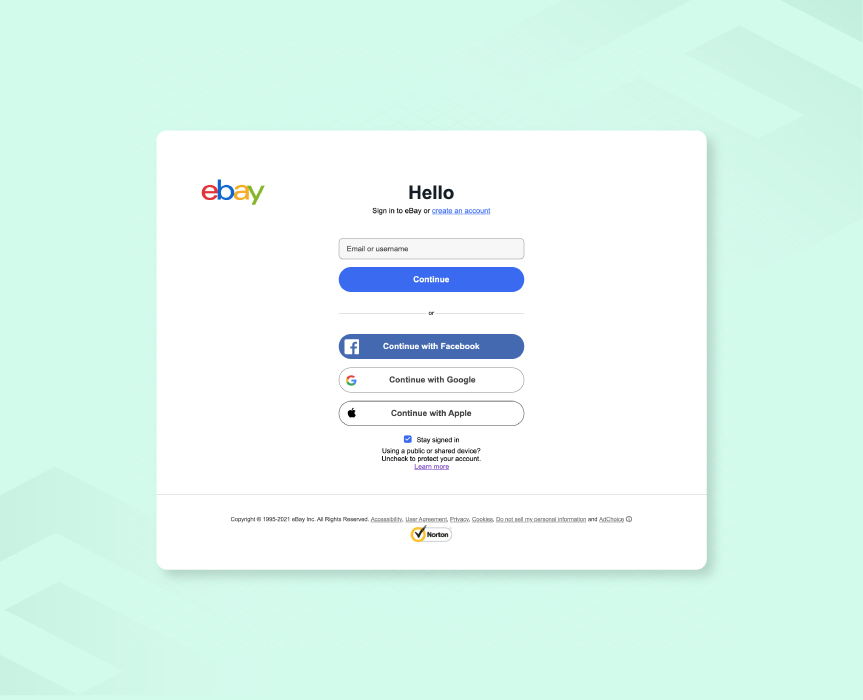
So, these are the top 5 reasons and solutions for the online shopping cart abandonment rate. To learn more, check out some other helpful tips from a famous entrepreneur and analyst expert Neil Patel:
Wrapping Up
Shopping cart abandonment occurs because of different reasons. Reducing the shopping cart abandonment rate is one of the most efficient ways to increase conversion. Forbytes hopes that our basic guidelines will help you improve top ecommerce metrics.
If you need help with setting up or polishing your eCommerce store — just get in touch. Our team is more than happy to help you make it shine.

Our Engineers
Can Help
Are you ready to discover all benefits of running a business in the digital era?

Our Engineers
Can Help
Are you ready to discover all benefits of running a business in the digital era?









